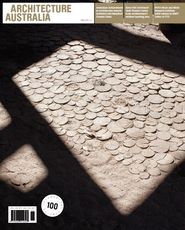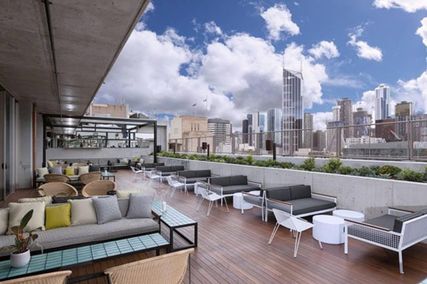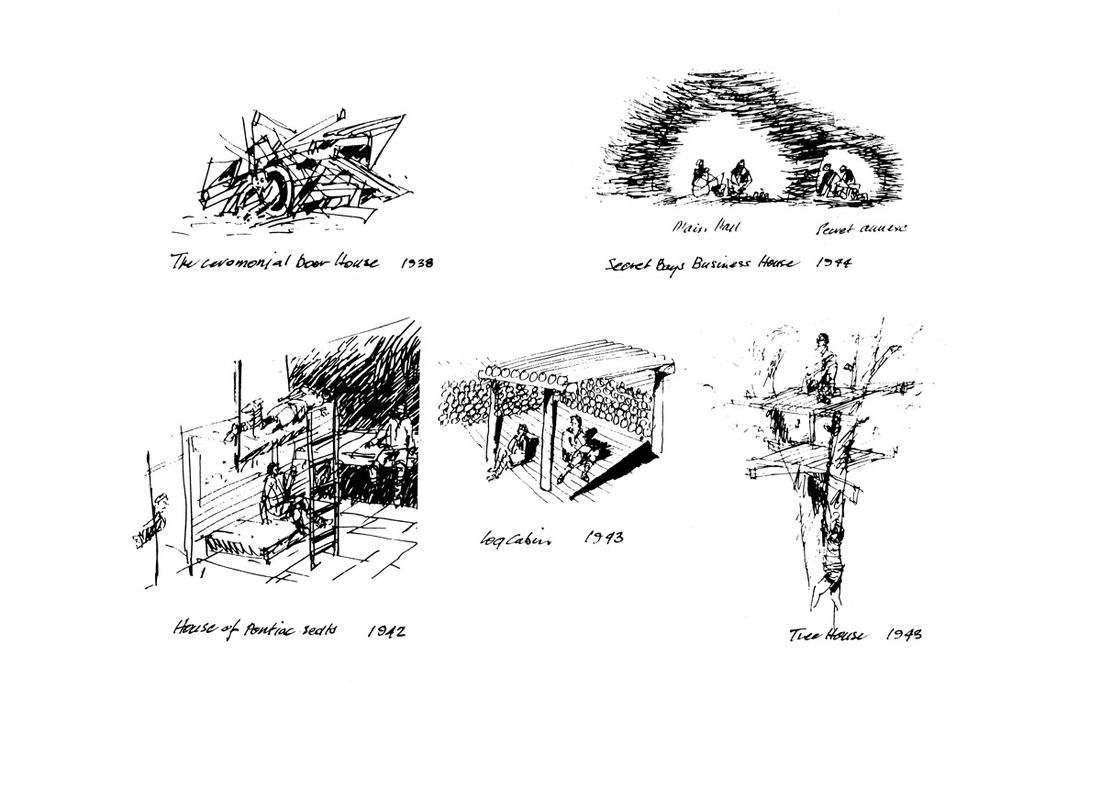This conversation took place at Graeme Gunn and Suzie Boyd’s house in Eltham, Victoria on 15 January 2011. It was a rich conversational ramble about Gunn’s work, life, and times. It was part of the Lustre project, initiated by Des Smith (Deakin University) and Jonathan Gardiner and Patrick Ness (Cox Architects and Planners) and Bruce Allen (Allen and Naughtin Architects). Lustre attempts to engage significant Victorian architects and academics from the 1960s to 80s in conversation sessions with colleagues and members of the Lustre crew, discussing their lives and times in architecture. The members of Lustre have a rangy list of questions to help order these conversations, but the real value is in this conversational manner with colleagues and the length of the conversations.
On becoming an architect
Des Smith So why did you become an architect, Graeme?
Graeme Gunn That’s a very interesting question. I suppose, historically, my father was a builder. In fact, we come from a long line of builders: my maternal ancestor was a carpenter on the Sirius.
DS So you were a First Fleeter?
GG Yeah, he was the ship’s carpenter.
David Beynon So you traced your genealogy back?
GG Yeah, there’s actually a book by one of my relatives, who I didn’t know until the book was produced. My maternal ancestor is in Tasmania - she was a convict on the third ship. They ended up just out of Hobart. On my father’s side, they were Scottish and went to Sydney, and then Port Fairy and then to Dunkeld, which is near Hamilton. They were builders and coffin makers.
DB The full range of carpentry needs for one’s life.
GG Anyway, in Hamilton there are always building materials everywhere. I just accessed those. There were tools there as well; the workmen all just left their tools. If it was raining, they’d come and make windows in the sheds and things like this. You don’t realize just how beneficial that all was. We’d make toys out of materials - there were western red cedar shingles lying around. Growing up I was reasonably good at school. I loved sport. Then, at about fifteen, I finished the fifth year and had this long, unconsummated relationship with a girl where we stayed up talking a lot. I just fluffed through on the leaving certificate. The next year, back at matric, I wasn’t focusing at all. After the first term, my results weren’t very good and my parents were quite critical of my endeavours and behaviour - and the fact that I was not always discreet in my actions. My father said, “You better leave school.” I said, “Yes, well I’m going around Australia. That’s what I’ll do.” I had no clue where I was going or how I was going. I had no money to go anywhere. So Monday morning came, and he looked at me and he said, “Get out on the job.” So I jumped on the back of the truck with the boys and stayed there for six years, but I really didn’t like it.
DS So these drawings are from that time? One of them has got 1938 and another has got 1944?
GG What can I say? No, they’re post construction.
DS Because the ‘38 one has definitely got some Zaha Hadid attached to it.
GG The ‘38 one is the first one - see, that was
a pile that came from a job lot. My father would have demolished a house and left it in the backyard, and I was attracted to it because it had this timber dunny seat. That was the entrance to the hut inside.
DS So was that a hut you made?
GG Yeah, they’re all huts that we constructed. The one to the right at the top - that came about with the felling of a eucalypt. It was all there, piled up, and suddenly I could just imagine the space. So we reconstructed it with the hole in the centre. The point about the little annexe at the side was that five boys don’t always get on. One was a pain in the arse to the others - so we used to take the plums up there and we’d sit in the little annexe where we could see in but they couldn’t see us. This was the way that worked - it was a secret space.
DB Do you ever look back and see a connection between the things you did then and the spaces you made later?
GG Yes, very much so. The more I reflect on this, I try to get my act together to write something. It’s in the notion of space - it’s intrinsic, no doubt about that, because I do think about space first.
DS So do you draw a space? That’s what you’re attempting to make?
GG No. I used to design places in my mind at night - to the point where you’re so reiterative that you go stupid following a thing around. There’s a line of separation that defines one space and that ties in with the component that is going to control the other space, and how they come together. Of course, during the day, they don’t work at all - never have - but you get some semblance of how it might happen.
DS There is a softness about this space in your house. I haven’t been in a lot of your projects, but there is a softness about them, even though they’re all regular.
GG Really? Soft in the sense of …?
DS Kind of gentle spaces, really comfortable.
GG Yeah, I guess I’m very much humanistic in that way. I don’t particularly like vapid spaces that are just about volume, with no sort of control and intimacy. Even tactility, I think, is a factor of space. This is one of the things that upsets me so much down at Docklands - most of the architects don’t think about surfaces and control of space. They still orient it toward the object, toward how it’s going to look.
DS I wouldn’t disagree with you. Is that
recent though?
GG Probably not.
DS This, your study/office, is not a remarkable space, but it’s very amicable and gentle. Gentle is my term for it - it’s a very nice space to just sit and talk in.
GG I love being in here.
DS There’s a kind of generousness about the space - not in terms of size, it just feels generous; it never crowds you. That kind of comfort is a lovely quality for architecture to have. Kevin Borland’s work used to have it, but it was more vivacious.
GG It was very gregarious, wasn’t it? It jumped at you.
On getting an education
GG I went to RMIT and saw Harry Winbush. I was just this kid from the country trying to tell him what I wanted to do, and he said, “You can’t do it.” I went off and I walked around Melbourne for a couple of hours and came
back after lunch and saw Max Freeland.
DS The historian?
GG Yeah. He was the head of the course under Harry. I said, “Well, I’ve decided to do it full time,” and he said that was terrific. He was very good, so I started the course in architecture. In the first year, I had to catch up on matriculation, so I did nine subjects including ones in architecture.
DS When did you decide to do architecture?
GG Well, that’s the point - I don’t know that. It was just that I was going down to do architecture. I had no introduction to it at all.
DB So when did you realize it was the right thing?
GG I didn’t. In matriculation, we had things like Taylor’s little book of studies, which gave you your selection subjects for tertiary education. Architecture must have been there, but they would have put down high maths and other sorts of qualifications, which I probably didn’t have. Forestry was one that I was interested in, but by then I was just fed up with the study at school and was rather irreverent to my teachers. It wasn’t working out, but there was no ultimate decision to say, “I’m going to do architecture.” What I did decide was that I’d go down and try to enrol in architecture.
DB So, as an architectural student, were there particular buildings that suddenly grabbed your interest?
GG No. I remember that somewhere I read you had to be interested in lots of things, even holes in the ground, so I used to walk around Melbourne when there was a hole being dug.
DS “A man was spotted looking at a hole in the ground.” Sounds like Monty Python.
GG I must have been translating this into some architectural imagery - it was a very creative period in my life. I was also destitute, so I really was up against the wall, very close to doing myself in. I sometimes didn’t have money for the tram fare home, and I’d get across the bridge at the Yarra and look over the edge and say, “Well, that’s one way to finish it.”
DS Are we talking mid 1950s?
GG This is ‘56.
DS So it’s a pretty vibrant time in Melbourne, because the Olympics were happening?
GG Yes, the Olympics were there, but I couldn’t even get a job cleaning up on the stands. I tried, but didn’t pass. I did, however, start working with Grounds, Romberg and Boyd, which was really good - I got that job before I finished the course in architecture.
DS Which you never finished?
GG No. The last two years of the course I was working full-time and studying full-time. But I remember that last year, the third year, it was start at nine o’clock, work till ten, because I was getting paid by the hour. That was the good thing - it was the first money I had in Melbourne, really. And then go home and do the schoolwork till three o’clock. Fortunately, with Benzedrine and those sorts of things, you could keep going.
DB So your formal qualifications are honorary?
GG Yeah. I went to Grounds, Romberg and Boyd after I’d finished the first three years. I did a registration exam, which was for the rehab guys coming back from the Second World War, so I was able to become registered. I’d been calling myself an architect on the Richardson House and I was reprimanded. So, no, I didn’t get an academic qualification. I went to RMIT as head of school, and dean, without any qualification. You couldn’t do that today.
DS But you went there with the backing of the Institute.
GG Yes.
On Being Australian
GG Being Australian is something you grow into. When you’re very young, you don’t know who you are or what you are - even now I’m still mostly a ten-year-old. It’s probably that you feel you are ten years old again, always. But as to who you are, it doesn’t really occur to you until you’ve lived through a lot of things - like your own history coming to you out of all the sources that surround us, of where your family has been and what it meant to them, and what they were doing - where your real thrust is coming from. You look at your kids as you get older and you see a lot of the habits you have invested in them, much to your distress. But this notion of being Australian is part of also going back to that sort of environment around Hamilton. We’d go to the state school in the main street of Hamilton. You’d look down the end of that street and there are the Grampians. When you get closer, there’s these wonderful red gums, which is park-like, the serenity of it all. My notion of the Australian bush - well, we grew up with Tarzan, and I was always doing a Tarzan thing somewhere, and the Swiss Family Robinson.
DS And by that you mean some direct relationship to the place?
GG Oh yes.
DS Not something manufactured, out of a book, from somewhere else?
GG No, no, no. But my brother, two years older than me, was a great storyteller when we were younger, and he fabricated all of these translations from the Swiss Family Robinson, for instance - we would spend two days on the weekend with this whole body of people, a caravan of people moving down the side of the house, and little bits of pegs or little blocks of wood or little stones. They all had their names. We’d move slowly along, and there’d be episodic things happen along the way. All of these were just fantasy images. But the notion of the bush - when I was fifteen, for instance, I went with a friend out to Nelson on the Glenelg River, and that was the first time I had what I considered a balance between bush and traversable bush. It wasn’t scrubby and it had an elegance about it. It was really fantastic, and there was a distribution of plants and open spaces. I still remember it as being totally different. It’s not your Mallee scrub I’m talking about; there’s a statuesqueness about the trees, a real sense of volume. I suppose it’s very Gothic.
On favourite buildlings
DS So what buildings in Italy were you thinking of when you said, “I only know buildings in Italy”?
GG I don’t know - buildings in Florence, and Brunelleschi’s Dome. You get a series of buildings that work together. The intriguing thing for me is the spaces, and the way a building addresses a space.
DB So more about the relationships between them?
GG Yeah, and the language - the dialogue between the space and the building, which is vastly different from many modern day buildings of the corporate kind or the institutional kind, where they set themselves up as imposing modernist examples of … what, I don’t know, of modernism I suppose. But these other buildings, in more ancient times, were really about having a discussion, and actually reading. There’s a story there in every building. There’s a danger that modern architecture doesn’t have a story.
On worthiness, pride, success and architecture’s social aspect
DS What do you think is your best building?
GG The building I loved most was the Scroggie House, which is no longer there.
DS They’ve renovated it out of existence?
GG Totally, the whole character. It’s interesting - I think there’s more than a building that you’re assessing here and making a comment on, in terms of preference. It has to do with the client and the relationship and how it all happened. It was lovely in all areas - they were beaut people and we just had fun doing it. You have clients who test you because they think they have to, clever clients like teachers and lawyers. Sometimes they have great difficulty in working collaboratively.
DB They have an adversarial approach to life.
GG Yeah, as if it’s necessary. It’s ingrained in them.
DS I was going to ask you, what is your most worthy building? But that might be the same thing?
GG Well, “worthy” means, what has it contributed to society. They’re all different because they have a different base for becoming. Prahran Market was a great community success. It did something - it achieved something that hadn’t happened before - and it was done in a modern age. It really did reintroduce a notion of community, collection and interaction in a protected space around the heart of the commercial activity. Portland Airport was a great sort of transition from a theme, and a recognition of a very peculiar function, and operation, into built form. Interestingly enough, they’ve now advertised to alter it, extend it, and add to it. We weren’t even invited! I’ve been totally irreverent, for most of my life, of the status quo if it seemed to be buffoonery, and that’s something that has never stopped me from doing anything. But I think there probably is an intrinsic acceptance of the fact that there was an order there.
DS Many of your generation of architects talk about the social structure behind buildings. They won’t tell you why the beams are dark grey rather than light grey.
GG Oh yes. There’s no doubt it was a hurdle - it’s the ultimate contradiction. You know you have a skill and you know that’s what you love doing, but if it was done to a point beyond the building performing at a social level, that was a no-no to me. It’s a bit like growing up - I grew up in a culture of not bragging. You were really cut off at the neck if you were a bragger. It’s always been a dilemma to be in a position where you do have some recognition, and I just feel very uncomfortable with that.
DB Maybe for subsequent generations the principal agenda has moved toward the environmental, away from the social side of things.
GG There was that, but also it probably was all done for you. When we talked about design, in the mid sixties, as a leaven for human comfort or aspiration, you were a real prick - a smart-arse prick - and what you really should be talking about was, how can I solve the social aspirations for people? That’s when the whole body of social experts rose to the top, and the design component of architecture was downgraded.
DS But Robin Boyd got into the design component, didn’t he?
GG He did but, at that time, he was regarded as out of kilter. I always said to Robin that he wasn’t interested in those social aspects. We went on the other way; we went overboard. I think I took the line that, yep, it’s right - architecture is not a performing art.
On travel and endeavour
GG I think it all relates to your intellectual capability, and often finances as well, and often maturity - that you’ve decided early enough that that’s what you need to do. You’ve got a plan and you’ve got a strategy and then that’s how you go about it. I had no capability in any of these areas, so it was more or less, as I said, by osmosis. It’s strange how things happen. You know, when you’re becoming a piece of humus, when you haven’t tried to do something. And the moment you attempt to do something, how much else happens in concert with it? And you get energized by doing those things, and other people get energized too. It’s bizarre because the real, I suppose, characterization is one in which, if you don’t do anything, you do atrophy. You just drop off, and it gets worse and worse. Your capability to do anything diminishes accordingly. So, while it seems a struggle, you have to keep jumping into the frying pan.
DS That’s good. I like the title there. Graeme Gunn - Not a piece of humus.
GG Well, as far as I’m concerned, that’s probably the way it’s gone.
Des Smith is professor of architecture at Deakin University, and a director of Giles Smith Architects. Dr David Beynon is a senior lecturer in architecture at Deakin University and a director of AlsoCan Architects.
Source

People
Published online: 18 May 2011
Images:
Graeme Gunn,
John Gollings
Issue
Architecture Australia, March 2011






















